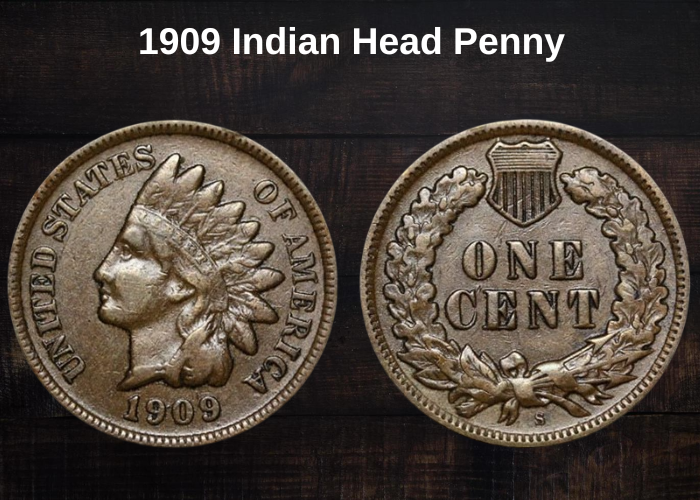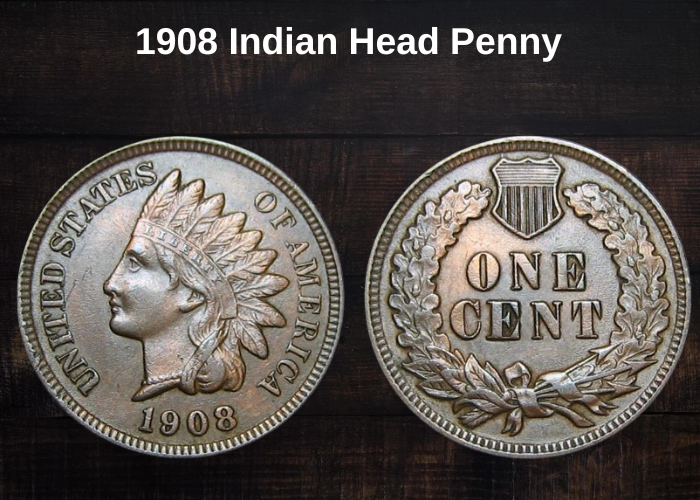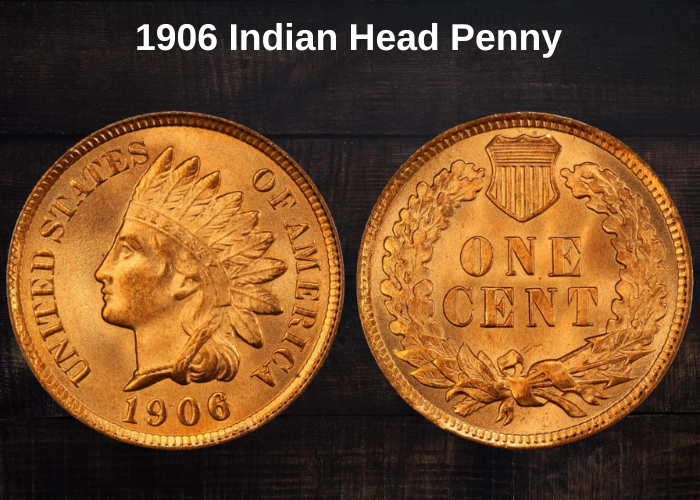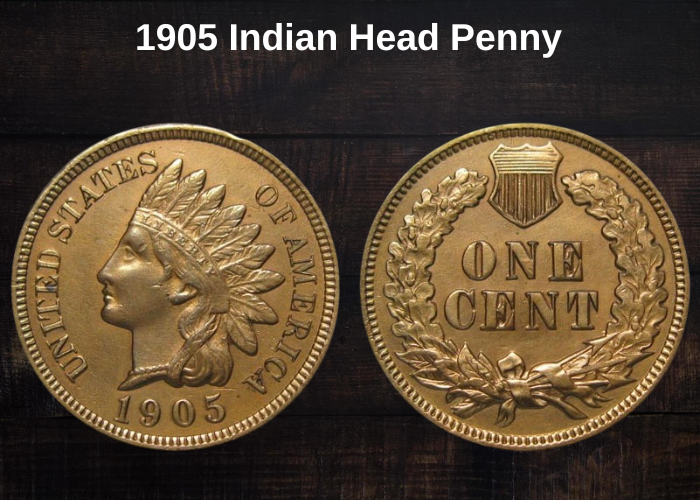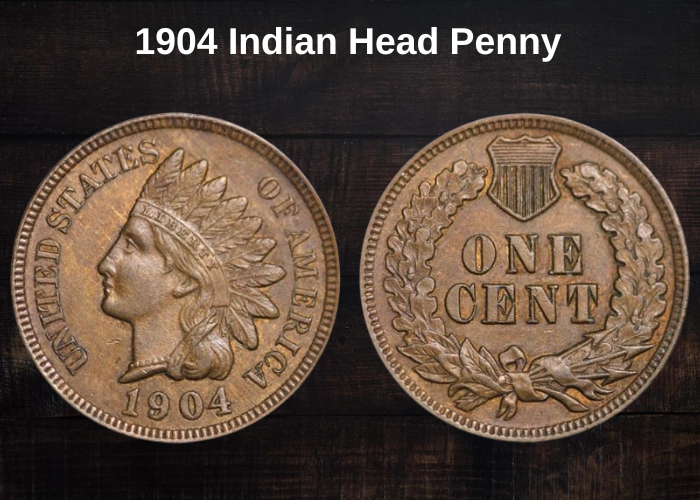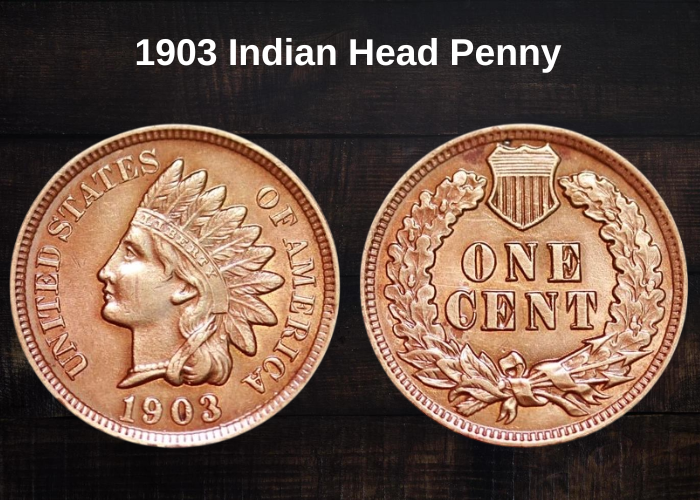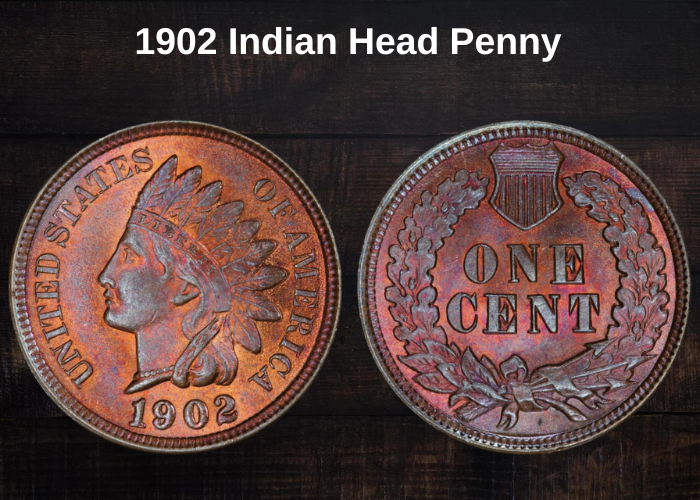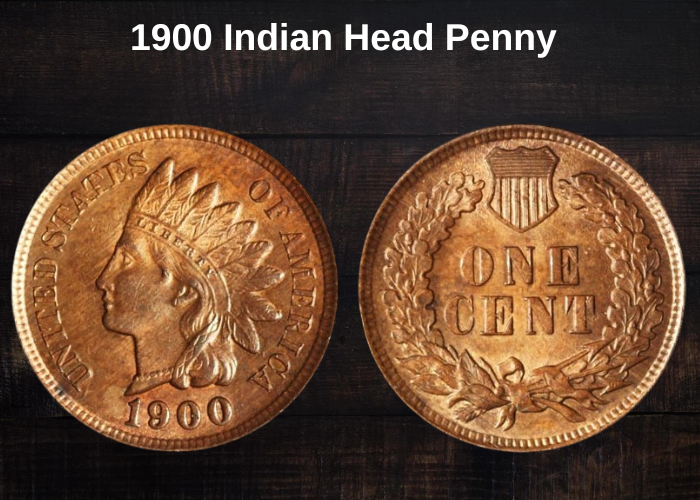The 1901 Indian Head penny holds historical significance, and its value is influenced by several factors, including its condition and rarity. Below is a breakdown of its value across various grades:
1901 Indian Head Penny Value Chart
| Coin | MS 60 | MS 62 | MS 65 | MS 66+ | MS 67+ | PR/PF 67+ CAM |
|---|---|---|---|---|---|---|
| 1901 Indian Head Penny | $70 | $110 | $700 | $2,650 | $30,000 | – |
- MS 60: At this grade, the penny is still in decent condition and can be worth around $70.
- MS 62: With slightly better condition, its value rises to $110.
- MS 65: A high-quality coin will command a significantly higher value of about $700.
- MS 66+: As the coin nears perfection, the value increases sharply to $2,650.
- MS 67+: A nearly flawless example could reach a staggering value of $30,000.
Context on the 1901 Indian Head Penny:
- The 1901 Indian Head penny is notable for the image of Lady Liberty wearing a Native American headdress. This design was initially meant to represent a Native American figure, but it bears Western features, which is an interesting historical detail.
History of the 1901 Indian Head Penny

The Indian Head Penny (1859–1909) holds a fascinating history, reflecting both the Mint’s adaptation to changing economic conditions and a significant shift in the design and material composition of U.S. coins.
Historical Context and Changes:
- Material Changes: Initially, the U.S. Mint produced coins with silver and gold, and the pennies were made of pure copper. However, during the gold rush of the 1850s, copper prices spiked, and the price of silver also surged during the Civil War. To respond to these changes, the Mint started adding nickel to pennies, resulting in an 88% copper and 12% nickel composition. Additionally, the diameter of the cent was reduced from 28.5mm to 19.05mm to help manage the costs associated with these precious metals.
- Flying Eagle Cent: The Flying Eagle Cent was the result of the earlier material changes, but it didn’t find much favor with the public due to its design and size. So, the Mint replaced it with the Indian Head Penny in 1859, which would become one of the most iconic coins in U.S. history.
- Design and Evolution: The Indian Head Penny’s design was crafted by James B. Longacre, the Chief Engraver at the Mint. Longacre’s choice of an Indian Head design was aimed at symbolizing American heritage. Around 1864, the coin’s composition shifted to 95% copper and 5% tin and/or zinc, likely due to the strategic importance of nickel during the war. Around the same time, Longacre added his initial “L” to the design.
Legacy:
The Indian Head Penny was minted for 50 years and remained one of the most popular coins of its era, deeply tied to the American spirit. Its design change and materials adjustments reflect the broader historical context of the time, including the U.S. economy’s evolving needs and the nation’s industrial and military expansion.
The Inspiration for the Indian Head Penny
James B. Longacre’s design of the Indian Head Penny reflects both symbolic and artistic choices that were deeply rooted in American identity, while also influenced by classical and contemporary ideas.
The Native American Headdress (Feathered Tiara):
Longacre chose to depict Lady Liberty wearing a feathered tiara, which he believed was a more fitting representation of the nation’s identity than the Phrygian cap used on earlier coins. The Phrygian cap had historically symbolized freedom, but Longacre felt it was connected to a past of bondage, particularly for emancipated slaves in Ancient lands. He saw the Native American headdress as a stronger symbol for America, representing both indigenous heritage and the spirit of freedom.
Lady Liberty’s Representation:
The coin’s obverse features a portrait of Lady Liberty, though there were some controversies surrounding her depiction. While the headdress symbolized a male warrior’s identity, Longacre worked to make Lady Liberty’s femininity clear by adding pearls around her neck, creating a balance of masculine and feminine elements.
Interestingly, some people found it odd that a female Liberty wore man’s headgear, and there were rumors that Longacre had modeled her after his daughter, Sarah, at age 12. Longacre and his daughter both denied these claims, and he later stated that he had actually been inspired by the Crouching Venus statue, an ancient Roman sculpture.
Reverse Design:
At first, Longacre had designed the reverse with a laurel wreath, a symbol of honor, but he soon revised it to include a shield and an oak wreath, which added additional layers of symbolism. These changes reflected the strength and unity of the United States.
- Shield: Positioned at the top of the wreath, the shield symbolized protection and defense.
- Oak Wreath: The oak was a symbol of strength and endurance, fitting for a country in its early years of nationhood.
- Ribbon and Arrows: The ribbon symbolized unity, while the three arrows at the bottom were a nod to the first three states—Delaware, Pennsylvania, and New Jersey—that joined the United States in 1787.
Through these choices, Longacre’s design represented a melding of American values: freedom, strength, unity, and national pride.
Features of the 1901 Indian Head Penny
Although we call this coin the Indian Head Penny, it actually features a Caucasian woman wearing a Native American headdress.
As for the technical terms:
- The obverse or heads side is the front of the coin, which shows Lady Liberty wearing the headdress, designed by James B. Longacre.
- The reverse or tails side is the back of the coin, featuring a shield and oak wreath.
- The edge is the thin side of the coin, while the collar or rim is the raised border around the coin.
- The mottos or legends are the inscriptions or phrases on the coin.
- The devices refer to the images or designs on the coin.
- The field is the background of the coin.
The Obverse of the 1901 Indian Head Penny
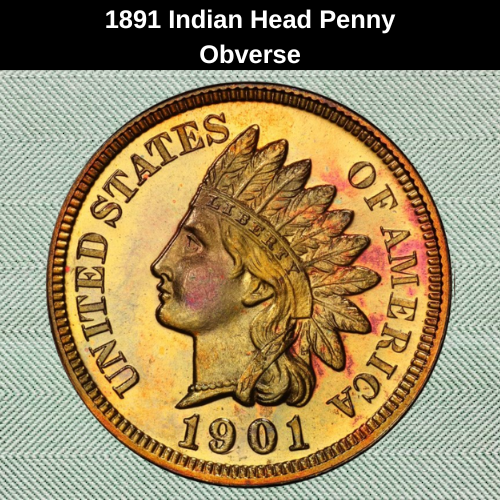
The coin features a youthful Lady Liberty, facing left. The inscription “United States” appears in front of her, while “Of America” is positioned behind her. She wears a feathered tiara with the word “Liberty” inscribed on the headband, and the mint date is located below her. There’s an L for Longacre subtly hidden in her hair, just beneath the lowest feather on the headdress, oriented clockwise. Lady Liberty is adorned with a string of pearls, and the coin’s edge is surrounded by denticles—small raised dots.
The Reverse of the 1901 Indian Head Penny
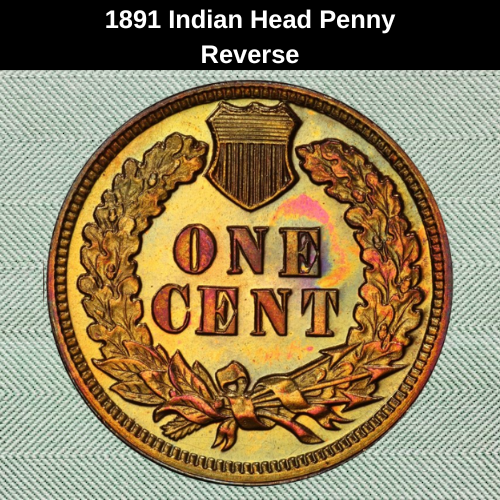
The reverse side of the coin features a wreath composed of oak and laurel branches, with the laurel positioned at the bottom. At the top of the wreath, there’s a shield nestled between the oak sprigs, with both horizontal and vertical stripes. The laurel leaves at the bottom are tied together with a ribbon that wraps around three arrows. The coin’s edge is adorned with denticles, and the central inscription reads “One Cent.”
Other Features of the 1901 Indian Head Penny
The 1901 Indian Head penny is the second coin in the Small Cent series, though it marks the fourth design modification when considering changes to the reverse imagery and the metal composition. In 1901, the coin was made up of 95% copper and 5% zinc or tin, or sometimes a mix of both. The coin weighed 3.11g and had a diameter of 19.05mm. Its edge was plain (smooth, without any reeds), but as mentioned earlier, the coin featured denticles or beading along its rim.
1901 Indian Head Penny Grading
When grading 1901 Indian Head Pennies, we use the Sheldon Scale, ranging from Poor (PO 1) to Mint State (MS 70). The condition of the coin significantly impacts its value, so understanding the grade is crucial.
In addition, proof coins are given the grade PR by PCGS and PF by NGC, with Deep Cameo or Cameo proof coins often being more valuable.
Here’s the grading scale for reference:
- 1: Basal State-1
- 2: Fair
- 3: Very Fair
- 4, 5, 6: Good
- 7, 8, 10: Very Good
- 12, 15: Fine
- 20, 30: Very Fine
- 40: Extremely Fine
- 50: About Uncirculated
- 60, 65, 70: Mint State
To determine the exact value of your coin, be sure to refer to grading guides and consult reputable resources.
1901 Indian Head Penny Value Guides
In 1901, all Indian Head Pennies were minted in Philadelphia, including proof coins. Since the coins were primarily made of copper, they were categorized by their color into three types:
- RD (Red): These are the highest quality coins, typically the most expensive, as they have a bright red appearance.
- RB (Reddish-Brown): These coins have a mix of red and brown, a slightly less desirable condition than the pure red coins.
- BN or BRN (Brown): These coins have fully oxidized into a brown color and are usually the most common, and least expensive.
A total of almost 80 million Indian Head Pennies were minted in 1901, but none of them had mint marks, as all were produced at the Philadelphia Mint. As mentioned, red coins (RD) are the most valuable due to their higher quality and appearance.
1901 No Mint Mark Indian Head Penny Value
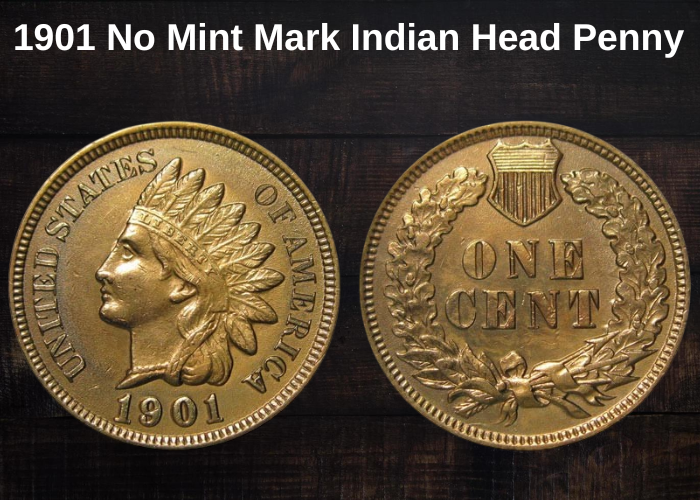
The Philadelphia Mint produced a total of 79,609,158 Indian Head Pennies in 1901, all of which were business strikes intended for circulation. None of these coins carried a mint mark, as they were all minted in Philadelphia.
Regarding the value trends over time for graded coins:
- An AU 58+ BN (brown) coin that was sold in February 2013 for $1,404 has significantly dropped in value over the next ten years, now worth only $42. Interestingly, only one such coin has been graded by PCGS, and that might be because AU 58 coins are commonly found, with PCGS having graded around 80 of them.
- However, higher-grade brown coins, such as those graded MS 66 BN, are still holding value, with a price of $600 in August 2023. Meanwhile, an MS 67 BN coin, which sold for $2,185 in March 2004, has decreased slightly to $1,850 due to the appearance of more coins in that grade.
- Red coins (RD) are doing much better, as demonstrated by a MS 67+ RD coin that sold for $33,600 in January 2021. This coin is one of only two known examples, and the value hasn’t changed significantly since the sale due to its rarity.
These fluctuations show how the condition, rarity, and color of Indian Head Pennies can significantly affect their market value over time.
1901 (P) Proof No Mint Mark Indian Head Penny Value

In 1901, the Philadelphia Mint produced 1,985 Proof Pennies. These coins were not intended for circulation but were meant for collectors or for the mint’s archives. Proof coins are highly detailed and have distinct characteristics that set them apart from regular coins:
- Mirror-like fields: The field (background) of the coin is shiny, giving it a reflective, almost glass-like appearance.
- Frosted devices: The raised elements (such as the numbers, letters, and images) are frosted, creating a contrast with the reflective background.
- Die preparation: The dies are scrubbed with horsehair to make them shiny, and the frosted parts of the coin are treated either with acid or laser texturing to increase the contrast.
Because of the meticulous process, only the first few hundred coins struck from a die display the Deep Cameo or Cameo appearance. Burnishing is also applied to the blanks to enhance their shine, achieved by tumbling them with 6mm stainless steel balls in a vat before they are struck by the press.
Pricing for Proof Coins:
- The highest grade proof coin for 1901, a PR 67+ CAM (Deep Cameo), sold for $49,938 in January 2020. This is the highest-known grade, and its value remains high, being worth approximately $50,000 in August 2023.
- PR 66 CAM coins are priced at $12,500.
- PR 66 BN coins were valued at $3,220 in August 2006, but their value has dropped to $1,050 due to 11 of them being graded by PCGS.
- PR 67 BN coins are valued at $2,150, while PR 67+ RB coins were sold for $9,988 in August 2012. However, the value has since dropped to $550 after more coins of this grade were discovered.
- A PR 68 RD coin, which was valued at $17,250 in September 2006, now stands at $15,000 in August 2023.
The value fluctuations depend on the rarity and condition of the coins, especially in relation to how many coins are graded in a specific category. The highest-grade coins maintain a premium, while coins in lower grades see their value diminish as more examples surface.
Rare 1901 Indian Head Penny Errors List
Even a finely tuned operation like the US Mint can occasionally make errors, and these mistakes can cause the value of a coin to soar to incredible heights. These errors can range from using incorrect planchets (the flat disks that will become coins) to unintentionally striking a design on a piece of stray metal. Naturally, some of these errors are more valuable than others, so let’s take a closer look at them!
1901 Indian Head Penny Broadstruck Error
The rim of a coin, as we discussed earlier, helps maintain its shape and ensures it holds its face value. It’s typically created using a detachable three-piece collar mold or an upsetting machine. However, sometimes the rim can be affected, resulting in a flatter and thinner edge. This type of error is called a broadstrike. Even coins with broadstrikes in lower grades, like VG 10 BN, can still be worth around $50.
1901 Indian Head Penny Curved Clip
The planchet starts as a coiled metal sheet, which is flattened in a blanking machine and then punched into discs of the correct size. The leftover metal often has holes in it, and if a coin is struck on one of these remnants, it may have curved clips next to the holes. While this type of error isn’t particularly rare or valuable, it can still fetch a few dollars. Even after being cleaned, such a coin recently sold for $50.
1901 Indian Head Penny Double Struck Off-Center
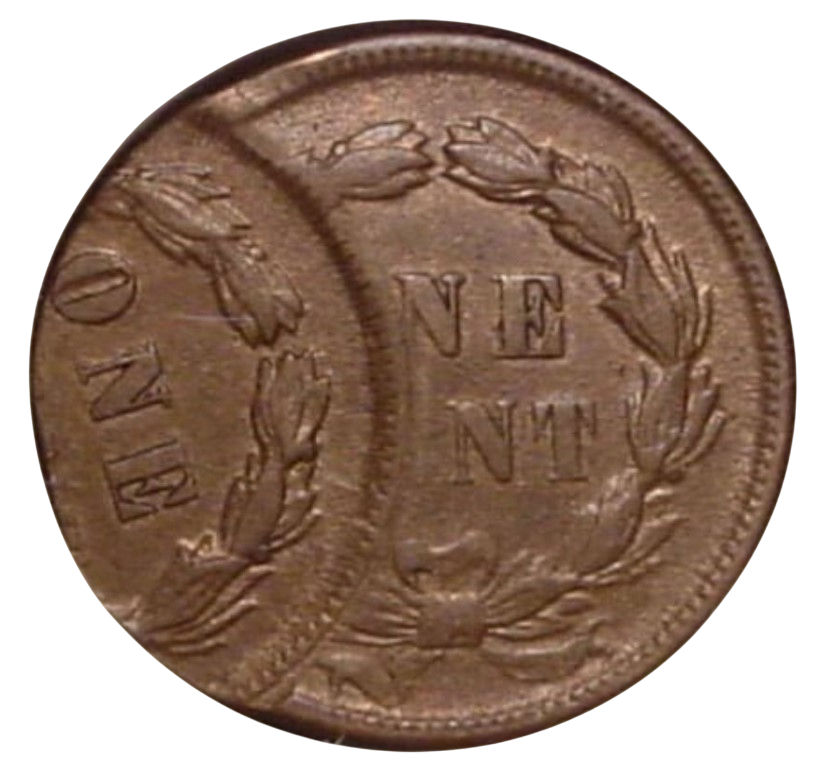
To make a coin, the feeder finger pushes the blank between two dies for striking. However, sometimes the blank isn’t positioned correctly in the center, or it might start to exit the press before being struck again. Both scenarios can cause off-center errors, and if the second strike happens to land in a different spot, it can result in overlapping images. An example of such an error was an AU 53 BN coin with both an off-center and double strike, which sold for $745.
1901 Indian Head Penny Double Struck in Collar
The 1901 Indian Head Penny Double Struck in Collar is another intriguing mint error. In this case, the coin was nearly out of the mint when it got struck a second time, but only the collar was restruck, resulting in visible overlap on the beaded rim. You can also spot slight doubling on the profile of Lady Liberty and the date, especially when using a coin microscope. In F 15 condition, this error coin is worth around $180.
1901 Indian Head Penny Repunched Date
The 1901 Indian Head Penny with a Repunched Date (RPD) is a mint error where traces of overlap or doubling can be seen on the individual numbers of the mintage year. This happens when the coin shifts slightly between strikes, causing the digits to be stamped multiple times. The repunched date can be spotted more clearly with a jeweler’s loupe or a coin microscope. An AU 50 grade RPD sold for $150 on eBay in 2016.
1901 Indian Head Penny Struck Off-Center
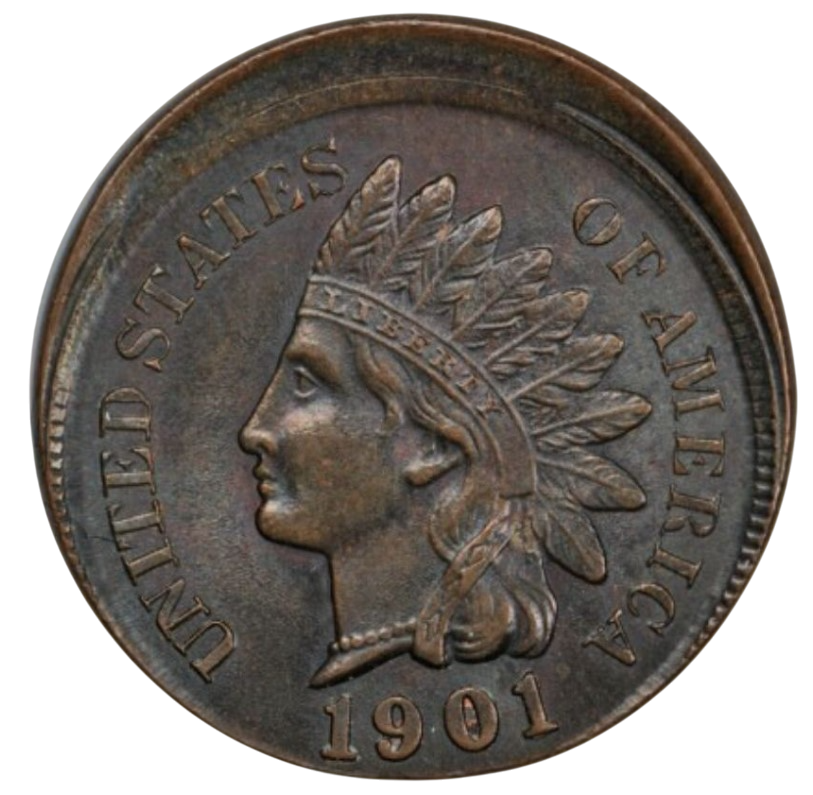
When a coin experiences a double or triple strike, it can lose its shape as some of the metal is pushed out of the collar. If the blank shifts before the first strike, only part of the surface will catch the design, leaving the rest of the coin blank. This scenario occurred with certain 1901 Indian Head Pennies, resulting in partial imprints. The value of these coins depends on their condition: an AU 55 sold for $180, an AU 58 for $285, and an MS 64 BN for $515.
1901 Indian Head Penny FAQ
What is the Error on the 1901 Indian Head Penny?
The 1901 Indian Head Penny is known for a notable error labeled FS 301. “FS” stands for First Strike, indicating that these mint mistakes were identified and officially verified within 30 days of the coin’s release. The FS 301 error refers to an RPD, or re-punched date, where you can observe a shadow-like overlap effect on the mint date, caused by the coin shifting between strikes during production.

